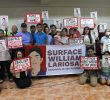DAVAO CITY, Philippines — The Committee on Agrarian Reform at the House of Representatives is seeking to amend the age requirement of heirs of landowners under the Comprehensive Agrarian Reform Law.
The militant group Kilusang Magbubukid ng Pilipinas (KMP) however, slammed the move, saying a new law should replace the country’s land reform program instead.
In a statement on Wednesday, KMP described CARP as a “long-dead” program and that it is time for the House to enact a new and genuine land reform law.
“The proposed amendments to the defunct Comprehensive Agrarian Reform Program (CARP) is an outright insult to farmers’ demand for genuine land reform,” the group asserted.
HB 7425 was introduced by Bohol Rep. Rene Relampagos who also chairs the Committee on Agrarian Reform.
The bill seeks to remove the current 15-year-old age qualification of heirs of landowners as specified under the retention limit set by CARP.
“This sinister move clearly aims to ‘zombify’ the CARP law which expired last June 30, 2014. Big landowners who do not want their lands to be covered by land reform are obviously behind this proposal of Rep. Relampagos,” Danilo Ramos, chair of KMP said.
The measure, Ramos added, is an affront to the landless farmers.
The group also took note of the 30th anniversary of CARP, the agrarian reform program that was extended for another 10 years after its expiration in 1998 during the administration of President Joseph Ejercito Estrada. CARP was again amended, renamed as CARPER (with reforms) and extended for another five years during the reign of former President Gloria Macapagal-Arroyo.
Ramos said farmers constantly protested against the implementation of CARP and CARPER.
The group also hit the administration of President Rodrigo Duterte for its failure to enact a program for genuine agrarian reform.
“In 2007, farmers proposed the Genuine Agrarian Reform Bill (GARB) and was sponsored by Anakpawis Partylist,” KMP claimed, adding that such measure has been pending in the lower house for more than a decade now.
“The farthest it reached in the legislative is at the committee level. Series of national consultations were accomplished over the years, and farmers showed overwhelming support for the passage of GARB,” the group added.
Ramos noted that it is already high time for Congress to consider GARB as its members owe it to their constituents to enact significant reforms.
Fixated in Boracay
“President Duterte’s obsessive fixation with Boracay Island shows his myopic view and attitude towards agrarian reform, its importance in genuinely addressing the demands of Filipino farmers, and in developing the national economy.”
This was the central message of a separate statement issued by KMP on Wednesday.
Antonio Flores, the KMP secretary-general said that the President wants to declare the entire Boracay Island as a land reform area but he also wants to keep big landlords happy by refusing to dismantle big landholdings in the country.
Such big landholdings, Flores added, are ought to be covered by the land reform program of the government a long time ago.
KMP also quoted a data from the Department of Agrarian Reform (DAR) indicating that some 15.5 hectares in Boracay Island are eligible for land reform
According to the Department of Agrarian Reform (DAR), some 15.5 hectares of land in Boracay is eligible for land reform following the earlier declaration of Duterte that he wants the entire island to be subjected to land reform.
The government eventually closed the island from local and foreign tourists for a period of six months for rehabilitation.
“Farmers in numerous big landholdings are engaged in local struggles to defend their position in the land and assert their right as actual tillers of the land,” Flores said.
He added that big landholdings and haciendas should be prioritized by DAR and the Duterte government for land reform coverage as there are actual farmers within these haciendas cultivating and asserting their right to said lands.
“A new and genuine land reform program is necessary for the development of the country’s largest productive force – the farmers, and for the economy in general. Free land distribution should also be a component of a new land reform program in order to veer away from the failures and shortcomings of the previous government land reform programs,” Flores pointed out.
Following Duterte’s declaration of Boracay Island as land reform area, Flores also urged him to proclaim the following big landholdings as agrarian reform areas.
These landholdings include the Hacienda Luisita in Tarlac with 6,453 hectares; Hacienda Looc in Batangas with 8,650 hectares; Hacienda Roxas in Batangas with 2,500 hectares which is divided into Hacienda Palico (1,024 has.), Hacienda Banilad (1,050 has.) and Hacienda Caylaway (867 has.); Hacienda Dolores in Porac, Pampanga with 761 hectares; Hacienda Yulo in Sitio Buntog, Canlubang, Laguna with 7,100 hectares; Yulo King Ranch in Palawan with 39,000 hectares; Fort Magsaysay Reservation Area in Central Luzon with 48,070 hectares; Hacienda Zobel or Hacienda Calatagan in Batangas with 2,000 hectares; Hacienda Larrazabal in Ormoc, Leyte with 6,500 hectares; the Araneta Estate in Bulacan with 3,000 hectares; Hacienda Belt in Bondoc Peninsula, Quezon Province; Danding Cojuangco Haciendas in Negros with 5,030 hectares; Lorenzo-Lapanday plantations in Mindanao with 6,000 hectares; Floirendo plantation in Mindanao with 8,500 hectares; the DMCI-Consunji logging areas in Sultan Kudarat with 102,954 hectares; and the San Miguel Corp. energy areas in Compostela Valley with more than 19,000 hectares. (davaotoday.com)










